TIFFS maneuvers can reduce cost of cataract surgery in developing countries
Reliable low-cost procedures can make cataract surgery available to more patients.
An estimated 20 million people worldwide are blind because of unoperated cataract. More than 95% live in developing nations where cataract surgery is hampered by insufficient manpower and surgical means.
Modern cataract surgery as performed in developed countries requires the use of high quality IOLs and viscoelastic materials. Surgery in developing countries demands simple yet reliable methods of cataract extraction and optical correction to be able to treat the huge number of patients requiring surgery.
Many ophthalmic units in developing nations have scarce financial resources and cannot afford the purchase of sufficient cataract trays, IOLs and viscoelastic materials. The use of low-cost IOLs, methylcellulose viscoelastics and anterior chamber maintainers has reduced the cost of cataract surgery. Further cost reduction is possible by using tight incisions (TI) and basic salt solution “fountain flows” (FFS) and by taking advantage of the elasticity of PMMA lenses. These constitute the TIFFS maneuvers.
Materials and methods
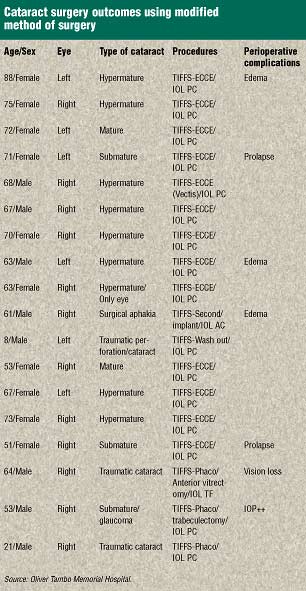 Between May and August 2000, 18 patients
underwent cataract surgery at Oliver Tambo Memorial Hospital using a modified
method of surgery — the TIFFS maneuvers — and IOL implantation. Eight
patients were male and 10 were female. Ages ranged from 8 to 88 years, average
60.44 years. The right eye (RE) was involved in 12 patients and the left (LE)
in six patients. Fourteen patients presented with age-related cataracts
(submature, mature and hypermature), one patient being also monocular; three
patients presented with traumatic cataract/perforation; one patient was aphakic
from previous cataract surgery.
Between May and August 2000, 18 patients
underwent cataract surgery at Oliver Tambo Memorial Hospital using a modified
method of surgery — the TIFFS maneuvers — and IOL implantation. Eight
patients were male and 10 were female. Ages ranged from 8 to 88 years, average
60.44 years. The right eye (RE) was involved in 12 patients and the left (LE)
in six patients. Fourteen patients presented with age-related cataracts
(submature, mature and hypermature), one patient being also monocular; three
patients presented with traumatic cataract/perforation; one patient was aphakic
from previous cataract surgery.
We used TIFFS maneuvers in all 18 patients. This was combined with extracapsular cataract extraction (ECCE) and posterior chamber (PC) IOL implantation in 13 cases, wash-out of the lens and PC IOL in one patient, secondary IOL implantation in another patient, and phacoemulsification procedures in three other patients. The phacoemulsification procedures were simple phaco and PC IOL in one patient, phacotrabeculectomy and PC IOL implantation in one patient, and phacoemulsification, anterior vitrectomy and transscleral fixation of the IOL in another patient.
All the patients were implanted with PMMA IOLs: Apex IOLs in 15 eyes and Lenstec IOLs in 3 eyes. No viscoelastic materials were used during the surgical procedures.
Techniques for TIFFS
The patient lies with his or her head elevated 5° to 10°. The superior rectus muscle is fixated with a 5-0 silk suture. A 1.5-mm limbal incision is made at 11 o’clock using a 15° Alcon or Sharptome knife (figure 1). Capsulorrhexis is performed through the incision (figure 2), followed by nuclear luxation. The incision is then enlarged to 6 mm and the nucleus is quickly expressed (figure 3); this is followed by irrigation and aspiration of the cortex remnants. One 10-0 nylon suture is used to close about 2 mm of the incision from the opposite side.
A Simcoe or Gills/Welsh irrigation and aspiration cannula is connected through the long silastic tube to the balanced salt solution infusion bottle (figure 4). The drip knob is opened and the cannula is introduced, portal side up, through the newly closed tight incision on the left (figure 5). The saline flush (that is, the “fountain flow”) is enough to gently raise the cornea and preserve the anterior chamber.
The PMMA IOL is introduced, and the lower haptic and optic are placed in the bag (figure 6). The IOL is compressed slightly toward the scleral wall, and the upper haptic is introduced into the anterior chamber and released to settle into the bag (figure 7). The wound is then closed, adding two or three more 10-0 nylon sutures (figure 8).
Results and discussion
There were no perioperative complications in 14 eyes. Two eyes had postoperative corneal edema, which responded in a few days to topical steroid treatment. One eye had vitreous loss during surgery; another eye had elevated IOP, which required anti-glaucoma treatment for some days.
It was traditionally thought that intracapsular extraction was the best way to approach cataract surgery in countries suffering constraints of infrastructure, manpower and finance. However, extracapsular extraction has been successfully performed. Phacoemulsification, performed in better equipped centers, has also been reported as being reliable.
There are three basic requirements for performing modern cataract surgery: a standard cataract tray (and eventually a simple phaco machine), reliable IOLs and viscoelastic materials. By using low-cost IOLs and viscoelastic materials the cost of the procedures can be reduced. The IOLs produced by the Fred Hollows Foundation, which are distributed in South Africa by Apex Vision, and the Lenstec IOLs, distributed there by STAAR, are to the best of our knowledge the least expensive PMMA lenses on the market. Several viscoelastic materials are relatively inexpensive. The anterior chamber maintainer is a viable alternative to viscoelastics. However, this simple surgical tool requires an extra portal of entry into the anterior chamber and is not always available at ophthalmic units.
In our opinion, the TIFFS maneuvers eliminate completely the need for viscoelastic materials during cataract extraction and IOL implantation. The corneal incision through which capsulorrhexis is done, as well as the lateral incision which is closed around the tip of the Simcoe irrigation and aspiration cannula, are tight incisions. This ensures preserving the depth of the anterior chamber. The saline flow directed upwards (“fountain flow”) raises the dome of the cornea and permits easy implantation of the lower haptic and most of the optic in the bag. Gently pushing the upper haptic compresses the lower haptic through the scleral wall and allows implantation of the upper haptic. This spring mechanism is due to the elasticity of the PMMA haptics. This mechanism, believed to be counterproductive when implanting dual purpose lenses, was found to be reliable when dealing with 3-piece PMMA IOLs.
As for the overall cost of the materials used, the PMMA lenses we uses cost about US$10 and a 500 mL saline bottle about US$8. If we allow the use of about 20 mL of saline per patient including wetting of the cornea, irrigation and aspiration of cortex material and IOL implantation, one 500 mL saline solution bottle will suffice for about 25 patients. This will cover most of the surgical procedures performed during one day in a busy facility in a developing country, such as a primary health care hospital or an eye camp setting.
We strongly believe that the TIFFS maneuvers can reduce significantly the price of modern cataract extraction in developing countries.
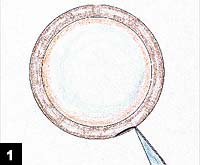 A 1.5-mm limbal incision is performed at 11 o’clock. | 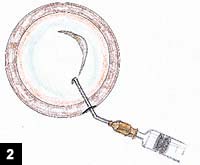 Capsulorrhexis and nuclear luxation are performed. |
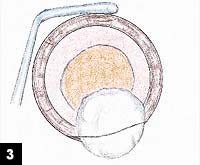 The nucleus is expressed. | 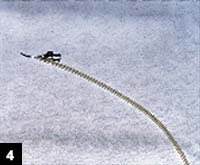 A Simcoe irrigation and aspiration cannula is used. |
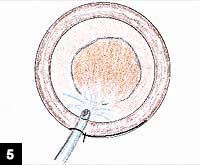 The saline flush is termed “fountain flow.” | 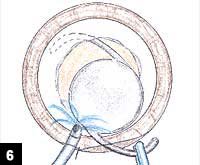 The IOL’s lower haptic and optic are implanted. |
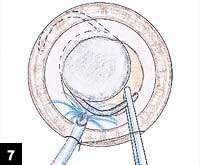 The upper haptic is compressed. | 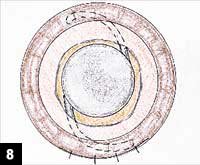 The final appearance of the eye. |
For Your Information:References:
- Roland R. Berger, MD, can be reached at Oliver Tambo Memorial and Germiston Hospitals, P.O. Box 2719, Edenvale 1610, Gauteng, South Africa; e-mail: rrberger@yebo.co.za. Dr. Berger has no direct financial interest in the products mentioned in this article, nor is he a paid consultant for any companies mentioned.
- Evans JR, Henning A, Pradhan D, Foster A, Lagnado R, Poulson A, Johnson GJ, Wormald RP: Randomized controlled trial of anterior-chamber intraocular lenses in Nepal: long-term follow-up. Bull World Health Organ. 2000;78(3):372-8.
- Thylefors B: The WHO Programme for the Prevention of Blindness and Cataract in the developing countries. Doc Ophthalmol. 1992; 81(3):3399.
- Berger RR: The International Agency for the Prevention of Blindness. Am J Ophthalmol. 1994; 406-407(letter).
- Brian G, Beaumont J, Hollows F, Holt P: Intraocular lens implantation – a model for the Third World. Aust NZ J Ophthalmol. 1988;16(4):321-4.
- Schwab L: Eyecare in Developing Nations, 2nd Ed. Oxford Medical Press, p. 48, 1990.
- Civerchia L, Apoorvananda SW, Natchiar G, Balent A, Ramakhrishnann R, Green D: Intraocular lens implantation in rural India. Ophthalmic Surg. 1993;24(10): 648-52.
- Gillies M, Brian G, La Nauze J, Le Mesurier R, Moran D, Taylor H, Ruit S: Modern surgery for global cataract surgery: preliminary considerations. Arch Ophthalmol. 1998;116(1):90-92.
- Ruit S, Tabin GC, Nissman SA, Paudyal G, Garung R: Low-cost high-volume extracapsular cataract extraction with posterior chamber intraocular lens implantation in Nepal. Ophthalmology. 1999;106(10):
1887-92.- Vajpayee RB, Bansal A, Sharma N, Dada T, Dada VK: Phacoemulsification of white hypermature cataract. J Cataract Refract Surg. 1999;25(8):1157-60.
- Boyd BF: Blumenthal’s mini nuc system. In Highlights of Ophthalmology, World Series of Ophthalmic Surgery, vol. II, Highlights of Ophthalmology Int’l, Panama, 1996, pp. 60-64.
- Berger RR: The “spring phenomenon” with Dual Purpose lenses. J Cataract Ref Surg. 119;19(2):3255-6.
